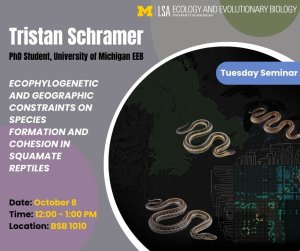Presented By: Ecology and Evolutionary Biology
EEB Tuesday Seminar Series - Ecophylogenetic and geographic constraints on species formation and cohesion in squamate reptiles
Tristan Schramer, University of Michigan, Phd Student EEB

This event is part of our ongoing Tuesday Seminar Series.
About this seminar: The ubiquity of species imbalance across the Tree of Life potentially reflects, at least in part, heterogeneity in macroevolutionary rates of speciation and extinction. However, how and why speciation rates vary within and between clades and biogeographic regions remains an open question. Many studies have tested for links between putative microevolutionary (subspecific) controls and macroevolutionary (superspecific) phenomena (e.g., speciation rates), but due to the noisiness of these biological data, have been unable to reach any consensus on speciation rate-limiting controls. In particular, variability in the taxonomic resolution of tip-level units—including over- and under-splitting—can potentially influence estimated rates of speciation, the consequences of which have not been rigorously explored. Given that geographic isolation provides only ambiguous evidence for reproductive isolation, the taxonomic treatment of allopatric forms has been inconsistent across clades, thus raising questions as to the comparability of our phylogenetic tip-level units. Using sympatry among close relatives as a heuristic for speciation completion, I will assess the impact of collapsing allopatric sibling species on macroevolutionary speciation rates in scaled reptiles (Order Squamata). I will then briefly describe my plans to investigate the ecophylogenetic limits to sympatry among squamates by modeling clade-level transitions from allopatry. I will also discuss leveraging higher-resolution ecological and distribution data from one North American snake tribe (Colubridae: Natricinae: Thamnophiini) to interrogate the robustness of these results. Finally, I propose to characterize the range-wide genomic structure of several species groups within Thamnophiini to explore extrinsic and intrinsic factors modulating species cohesion across heterogeneous environments and spatial scales.
About this seminar: The ubiquity of species imbalance across the Tree of Life potentially reflects, at least in part, heterogeneity in macroevolutionary rates of speciation and extinction. However, how and why speciation rates vary within and between clades and biogeographic regions remains an open question. Many studies have tested for links between putative microevolutionary (subspecific) controls and macroevolutionary (superspecific) phenomena (e.g., speciation rates), but due to the noisiness of these biological data, have been unable to reach any consensus on speciation rate-limiting controls. In particular, variability in the taxonomic resolution of tip-level units—including over- and under-splitting—can potentially influence estimated rates of speciation, the consequences of which have not been rigorously explored. Given that geographic isolation provides only ambiguous evidence for reproductive isolation, the taxonomic treatment of allopatric forms has been inconsistent across clades, thus raising questions as to the comparability of our phylogenetic tip-level units. Using sympatry among close relatives as a heuristic for speciation completion, I will assess the impact of collapsing allopatric sibling species on macroevolutionary speciation rates in scaled reptiles (Order Squamata). I will then briefly describe my plans to investigate the ecophylogenetic limits to sympatry among squamates by modeling clade-level transitions from allopatry. I will also discuss leveraging higher-resolution ecological and distribution data from one North American snake tribe (Colubridae: Natricinae: Thamnophiini) to interrogate the robustness of these results. Finally, I propose to characterize the range-wide genomic structure of several species groups within Thamnophiini to explore extrinsic and intrinsic factors modulating species cohesion across heterogeneous environments and spatial scales.